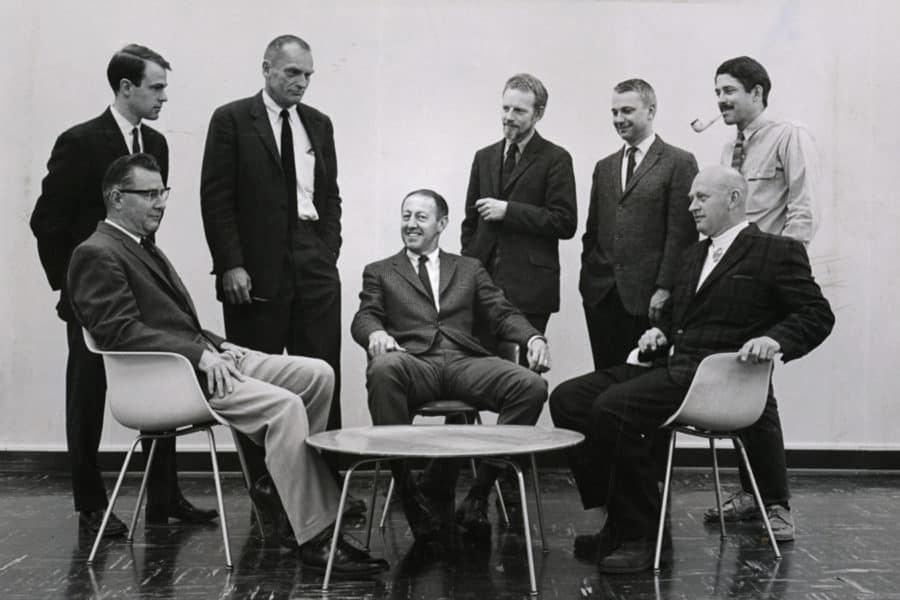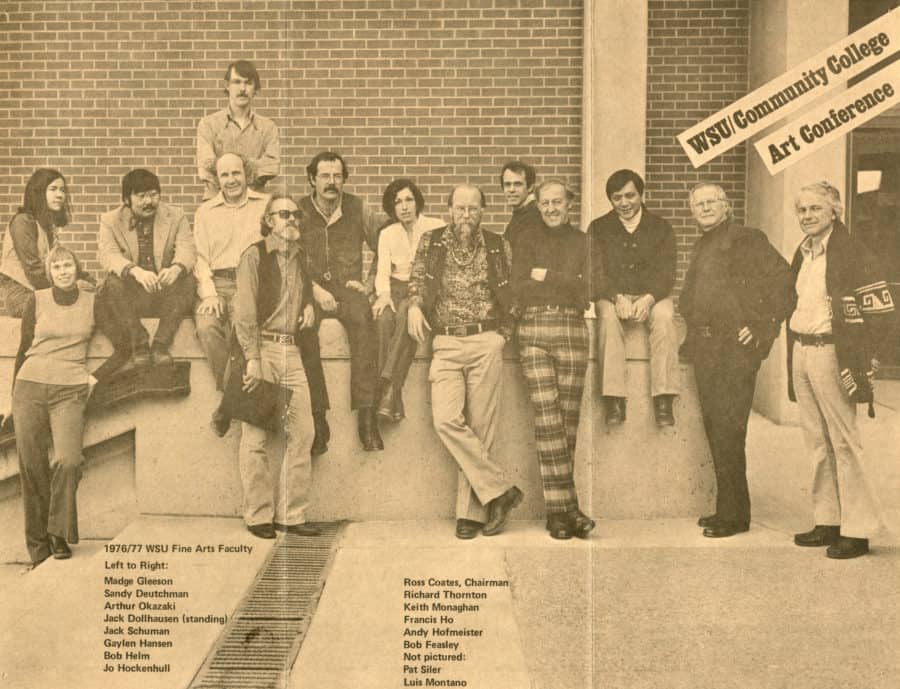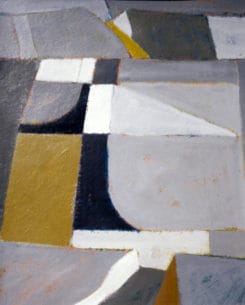About the Artist
Few contemporary artists who worked in the Northwest derived as much visual inspiration from the Palouse region of eastern Washington as did Keith Monaghan. His long association with the region is reflected in the images he created, which place him among the finest landscape abstractionists who have painted this most unique region of the Palouse.
Artists Glenn Wessels, Roland Petersen, & Clyfford Still were among other noted modernist American painters who also had come under the influence of the Palouse, also during their years teaching art at Washington State University.
Although the human figure appeared frequently in Keith Monaghan’s vast body of work, it remained the creative confidence with which he interpreted regional character emphasizing shape, color, and structure over narrative, which demonstrated the significance of his expressive ability as a modern regionalist.

Professor of Art, Instructor & Lecturer, 1947
Monaghan’s early visual vernacular was born of a period that became known as the Berkeley School, which preceded the SF Abstract Expressionists and early Bay Area Figurative movements.
A Bay Area native, Keith Monaghan began exhibiting his work in the early 1940’s, at the prestigious San Francisco Museum of Art and the De Young Museum at the Legion of Honor in San Francisco. He received numerous awards and recognition for his work throughout his lengthy exhibition career, which spanned more than fifty years. The artist exhibited in museums and galleries throughout California, Washington, and Oregon, as well as in Europe. Monaghan’s work is strongly represented in various corporate and private collections throughout the Northwest, San Francisco, Los Angeles, New York, and abroad; as well as the permanent collection at WSU Museum of Art, and numerous departmental collections throughout the Washington State University campus in Pullman, Washington.
Keith Monaghan studied Fine Art at the University of California at Berkeley in the early to mid-1940s where he received his Bachelors & Masters degrees; and was the recipient of the Taussig Traveling Fellowship to Mexico and New York. His teachers included some of the Berkeley School modernists such as Erle Loran, Worth Ryder, & Margaret Peterson.
Monaghan’s additional studies, primarily at the San Francisco Art Institute, took place during the era of such faculty notables as Richard Diebenkorn, Edward Corbett, & Jean Varda.
Keith was a lecturer in Art at Berkeley in 1946-1947. Later that same year, Monaghan was invited to WSU (which at that time was Washington State College until 1959) in Pullman, Washington to fill a sabbatical teaching position for one of his former Berkeley colleagues who had been teaching in Pullman. The following year, Monaghan was invited to join the faculty at WSU Fine Arts Department.

L to R – Standing: Richard Thornton, Robert Sterling, Gaylen Hansen, Robert Feasley, James Balyeat
L to R – Seated: Andrew Hoffmeister, Chairman Keith Monaghan, George Laisner
During his 39-year teaching career at WSU, Keith Monaghan served 21 of those years as Fine Arts Chairman, responsible for countless contributions to the Department of Fine Arts and the university at large. Among those particularly significant contributions were his efforts and advocacy for a designated facility to house the Department of Fine Arts. Dean Albert Thompson appointed Monaghan Chairman of the Fine Arts Department in 1951, during the administration of President Compton. Keith had then been teaching at WSU (WSC) for five years, and had become well acquainted with the minimal facilities, as well as the needs of the Art Department that existed at that time. Prior to the Fine Arts Center & Museum of Art which stand today, the Department of Fine Arts had no designated Fine Arts facilities and no designated exhibition space. Fine Arts classes were scattered throughout various buildings and inadequate facilities; shared with other university departments and often inappropriately outfitted for Fine Arts use.
As the Art Department grew, the University requested that the Art Department be moved and consider alternate locations. In 1968, after lengthy and careful consideration, Keith Monaghan accepted the site where the Art Building & Museum of Art currently stand. The tremendous efforts in planning the conceptual and physical characteristics of the facility began. Monaghan’s vision for the realization of a first class Fine Arts facility was a testimony to Keith’s integrity as a teacher, and to his respect for the role of teacher in the collegiate educational experience. The completion and dedication of this new Fine Arts facility was in 1972.
Monaghan’s tireless advocacy and diligence on behalf of this vision, eventually gave rise to the the Fine Arts Center & Museum of Art at WSU which stands today. Although many were involved, it was Keith Monaghan’s dedication to the teaching profession and his conviction to how much a first-class Fine Arts facility would enrich the experience of the students and all associated with WSU, which made the Fine Arts facility a reality.
As an exceptional educator and Fine Arts Chairman, Monaghan also built a modern art department, by bringing together faculty from many major art centers. He held seminars, which invited such prominent artists as Robert Motherwell, Larry Poons, and Jim Dine, markedly contributing to the growth of a modern and meaningful Fine Arts Center in Pullman, Washington.

WSU Museum of Art Annual Faculty Exhibit, 1998
The realization of the Fine Arts Center and Museum of Art served to enrich the experience of all associated with or visiting the campus in Pullman, Washington, not just Fine Arts students and Faculty. Keith’s wife Josephine “Dodi” Monaghan, an ambassador for the Arts in her own right, and a faculty hostess extraordinaire, was also a founding member of the ‘Friends of the Museum’ at WSU.
Keith Monaghan held strong convictions about the role of the artist in society. He successfully fought the stereotype of artist as a non-verbal and non-participatory member of society. During his tenure as Chairman, Monaghan directed much effort toward structuring events in order for the University to have maximum access to the Fine Arts Department, and in turn that the Art Department be recognized as an integral, vital and contributing member of the University Community. Many of the significant achievements of the Art Department weren’t given due acknowledgment, and therefore little of this history has been retained or is known today.
Keith Monaghan recognized the importance of exposure to the Arts in the university community. The strategic placement of the Fine Arts Center and Museum of Art across from the football stadium and Student Union Building was affirmed following every event, as crowds would migrate across the street or pedestrian mall to view the current exhibition at the Museum of Art afterward. The opening exhibit for the Museum of Art in 1972, under the curatorial direction of Harvey West, provided an impressive introduction of the Museum of Art, featuring a Rodin Sculpture exhibition.
During Keith Monaghan’s accomplished teaching and administrative tenure at WSU (1947-1986), he also served two consecutive terms on the Washington Arts Commission, vastly contributing to increased Art Appreciation & Art Education throughout the state and Northwest region. It was evident that Keith Monaghan’s contribution to art in the Northwest, the San Francisco Bay Area and beyond was not limited to painting. Teaching was a lifelong priority for him and he greatly valued being an educator.
On the day of Keith Monaghan’s retirement from WSU, Governor of Washington State, Booth Gardner, proclaimed May 10,1986 as ‘Keith Monaghan Appreciation Day’, during a dedication ceremony with WSU President Smith and countless colleagues in attendance, which took place within the Fine Arts Center facility which Keith Monaghan had worked so tenaciously to realize for Fine Arts students for many years to come. The Fine Arts faculty unanimously voted to dedicate the Fine Arts Center in Keith Monaghan’s name, in recognition of his career-long dedication, but sadly this never came to pass.

Following his retirement from teaching at WSU, the artist and his wife of 56 years, Dodi, returned to the SF Bay Area of their earlier years – residing part of the year in San Francisco and part of the year back in Pullman. Keith Monaghan continued to utilize his studio in the Fine Arts Center and continued participating in the annual Fine Arts Faculty Exhibition, until the year of his passing in 2001.
Keith Monaghan was an exceptionally far-reaching artist, educator and arts advocate, yet less recognized than many of his generational peers, regardless of geographic region, in large part because Monaghan felt that teaching (and making) Art was a higher calling than self-promotion as an artist.
Many admirers of Keith Monaghan’s work observe a kinship to prominent Bay Area artists such as Richard Diebenkorn, Wayne Thiebaud, David Park, and Roland Peterson.
As evidenced by his continual exhibitions in the Bay Area, including during his years in Pullman, Monaghan’s work remained of great interest and appeal to SF museum and gallery patrons, in addition to the continued major interest throughout the Northwest region and beyond. The breadth of Keith Monaghan’s work and its varied regional influences have created an exceptional artistic legacy.
The Artist’s Statement below accompanied his one-person exhibition at the Ebert Gallery in San Francisco in 1997:
“Many painters & poets in the history of art have been strongly affected by and responded to their physical environment. I think of my paintings as visual poems. My early work of the 1940’s and 1950’s was influenced by the unique character and feeling of the San Francisco Bay Area. My work from the 1950’s to 1990’s was influenced by the unusual forms, colors, and spatial qualities of rural Eastern Washington. My work then became a synthesis of these contrasting influences, having returned to residing in both locales.”
Keith Monaghan
